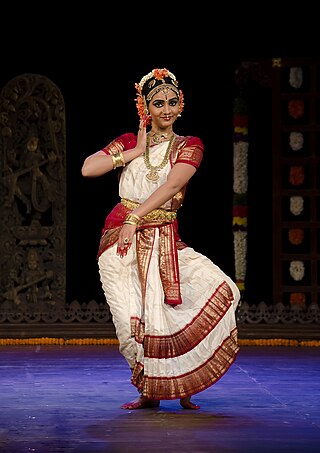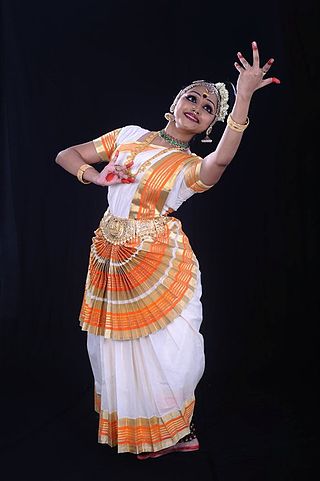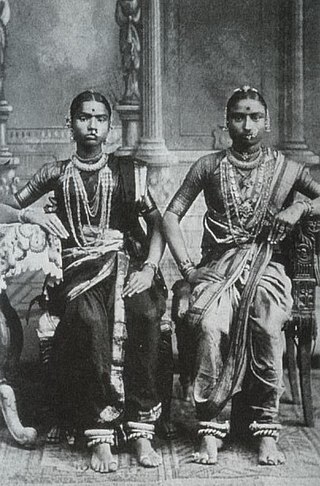Related Research Articles

Bharatanatyam is an Indian classical dance form that originated in Tamil Nadu. It is one of eight Indian classical dance forms recognized by the Sangeet Natak Akademi, and expresses South Indian religious themes and spiritual ideas, particularly of Shaivism and in general of Hinduism.

Kuchipudi is one of the eight major Indian classical dances. It originates from a village named Kuchipudi in the Indian state of Andhra Pradesh. Kuchipudi is a dance-drama performance, with its roots in the ancient Hindu Sanskrit text of Natya Shastra. It developed as a religious art linked to traveling bards, temples and spiritual beliefs, like all major classical dances of India.

Kathak is one of the eight major forms of Indian classical dance. It is the classical dance form from Uttar Pradesh. The origin of Kathak is traditionally attributed to the traveling bards in ancient northern India known as Kathakars or storytellers. The term Kathak is derived from the Vedic Sanskrit word Katha which means "story", and Kathakar which means "the one who tells a story", or "to do with stories". Wandering Kathakars communicated stories from the great epics and ancient mythology through dance, songs and music. Kathak dancers tell various stories through their hand movements and extensive footwork, their body movements and flexibility but most importantly through their facial expressions. Kathak evolved during the Bhakti movement, particularly by incorporating the childhood and stories of the Hindu god Krishna, as well as independently in the courts of north Indian kingdoms. During the period of Mughal rule, the emperors were patrons of Kathak dance and actively promoted it in their royal courts. Kathak performances include Urdu Ghazals and commonly used instruments brought during the Mughal period. As a result, it is the only Indian classical dance form to feature Persian elements.

Mohiniyattam is an Indian classical dance form that developed and remained popular in the state of Kerala. Kathakali is another classical dance form of Kerala. Mohiniyattam dance gets its name from the word Mohini – a historical enchantress avatar of the Hindu God Vishnu, who helps the good prevail over evil by developing her feminine powers.

In India, a devadasi is a female artist who is dedicated to the worship and service of a deity or a temple for the rest of her life. The dedication takes place in a ceremony that is somewhat similar to a marriage ceremony. In addition to taking care of the temple and performing rituals, these women also learn and practice classical Indian dances such as Bharatanatyam, Mohiniyattam, Kuchipudi, and Odissi. Their status as dancers, musicians and consorts were an essential part of temple worship.

Indian classical dance, or Shastriya Nritya, is an umbrella term for different regionally-specific Indian classical dance traditions, rooted in predominantly Hindu musical theatre performance, the theory and practice of which can be traced to the Sanskrit text Natya Shastra. The number of Indian classical dance styles ranges from eight to twelve, or more, depending on the source and scholar; the main organisation for Indian arts preservation, the Sangeet Natak Academy, recognizes eight – Bharatanatyam, Kathak, Kuchipudi, Odissi, Kathakali, Sattriya, Manipuri and Mohiniyattam. Additionally, the Indian Ministry of Culture includes Chhau in its list, recognising nine total styles. Scholars such as Drid Williams add Chhau, Yakshagana and Bhagavata Mela to the list. Each dance tradition originates and comes from a different state and/or region of India; for example, Bharatanatyam is from Tamil Nadu in the south of India, Odissi is from the east coast state of Odisha, and Manipuri is from the northeastern state of Manipur. The music associated with these different dance performances consists many compositions in Hindi, Malayalam, Meitei (Manipuri), Sanskrit, Tamil, Odia, Telugu, and many other Indian-Subcontinent languages; they represent a unity of core ideas, and a diversity of styles, costumes and expression.

Arjun Appadurai is an Indian-American anthropologist recognized as a major theorist in globalization studies. In his anthropological work, he discusses the importance of the modernity of nation states and globalization. He is the former University of Chicago professor of anthropology and South Asian Languages and Civilizations, Humanities Dean of the University of Chicago, director of the city center and globalization at Yale University, and the Education and Human Development Studies professor at NYU Steinhardt School of Culture.
Swarnamalya Ganesh is an Indian dancer, actress, Model and TV anchor.
K. P. Kittappa Pillai was the son of Sangita Kalanidhi K. Ponniah Pillai (1888-1945), a scion of the famous Tanjore Quartet, codifiers of the Bharatanatyam format.

Noboru Karashima was a Japanese historian, writer and Professor Emeritus in University of Tokyo, Japan. He also served as Professor Emeritus at the Taisho University, Japan. He was a prominent scholar of Asia in the studies of south Indian and South Asian histories. He has rewritten historical accounts on medieval south India and published a number of writings.
The Madras Devadasis Act is a law that was enacted on 9 October 1947 just after India became independent from British rule. The law was passed in the Madras Presidency and gave devadasis the legal right to marry and made it illegal to dedicate girls to Hindu temples. The bill that became this act was the Devadasi Abolition Bill.
Kristen Rudisill is a tenured Associate Professor of Popular Culture at Bowling Green State University, Research Associate in the South Asia Institute at the School of Oriental and African Studies. and a Fulbright Fellow. Her main research areas are dance, competitions, popular culture, India and Disney. She is working on books about Chennai's contemporary theatre and Indian dance competitions.

Deepak Shimkhada is a Nepali American educator, artist, art historian, author and community leader. He currently serves as an adjunct professor at Chaffey College in Rancho Cucamonga, California. He has previously held visiting and adjunct appointments at several universities in the United States, including Scripps College, Claremont Graduate University, California State University, Northridge, University of the West and Claremont School of Theology. His teaching career began in 1980 and although he is fully retired from full-time teaching, he currently teaches Asian art part-time at Chaffey College.

The Rādhikā-sāntvanam is a poem composed by the Telugu-language poet and devadasi Muddupalani (1739–90) concerning the marital relationship of the deity Krishna, his aunt Radha and new wife Ila, and the appeasement of the jealousy of Radha.
P. R. Thilagam, popularly known as Thiruvarur Thilagam, is an Indian composer, vocalist and exponent of Kuravanji, a traditional form of dance drama popular in the Indian state of Tamil Nadu. She hails from Kondi parampara of the Isai Vellalar community, a sect of women dedicated to the worship at Thyagaraja Temple, Tiruvarur.
Pushkar Sohoni is an architect, an architectural and cultural historian. He is an associate professor and the chair of the department of Humanities and Social Sciences at the Indian Institute of Science Education and Research, Pune.
Isai Vellalar is a community found in India in Tamil Nadu. They are traditionally involved as performers of classical dance and music in Hindu temples and courts of the patrons. The term "Isai Vellalar" is a recent community identity, people of minstrel occupation from various castes such as, Melakkarar, Nayanakkarar and Nattuvanar come under this term.

Rustom Bharucha is a writer, director and dramaturg based in Kolkata, India. He is a Corresponding Fellow of the British Academy and a retired Professor of Theatre and Performance Studies which he taught in the School of Arts and Aesthetics at Jawaharlal Nehru University, New Delhi, India, between 2012 and 2018.
R Muthukannammal is a seventh generation veteran Sadir dancer from the Indian State of Tamil Nadu. She is the only surviving person among the 32 Devadasis who served the deity at the Viralimalai Murugan temple and she is the last woman to have the ceremony pottukkattutal of dedicating oneself to God performed at the Viralimalai temple. In the year 2022, Govt of India honoured Muthukannammal by conferring the Padma Shri award for her contributions in the field of art. The dance form Sadir, variously called as Sadiraattam or Parathaiyar Aattam or Thevarattam, is a classical Indian dance from which was reinvented, modified and rechristened as Bharatanatyam through the efforts of E Krishna Iyer in 1932. However, Muthukannammal has chosen to call her art form Sadir, making her the only Sadir exponent today.
Coimbatore Thayi (1872-1917) was an Indian musician.
References
- ↑ "Davesh Soneji | South Asia Studies". www.southasia.upenn.edu. Retrieved 2021-07-08.
- ↑ "Davesh Soneji on Indian classical dance, working with hereditary artists: 'We need a new, radical epistemology and political grammar'". Firstpost. 2020-02-09. Retrieved 2021-07-08.